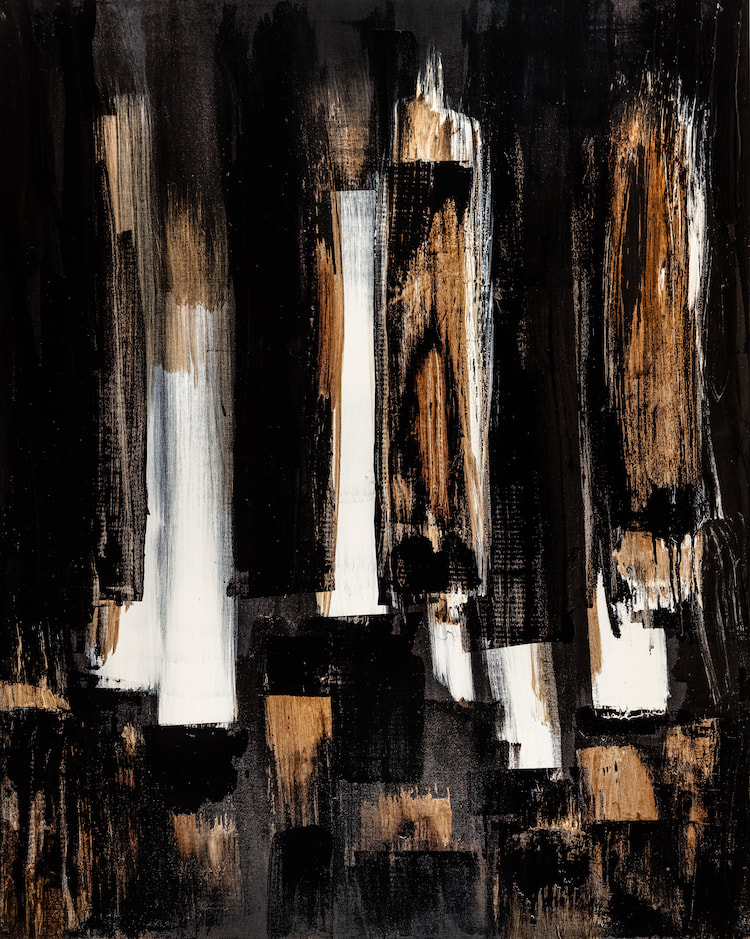Johnnie Cooper
throe on throe
Hyrst, 2018, oil and acrylic on canvas, 152 x 122 cm © Johnnie Cooper, Courtesy of the artist
During a 1950 radio interview with broadcaster William Wright [1], Jackson Pollock was asked a challenging question: if classical artists used pictorial representation as a means to express their world at the time, what do modern artists do today? Pollock’s reply was that “the modern artist… is working and expressing an inner world - in other words - expressing the energy, the motion, and other inner forces”.
|
|
Trying to capture this inner world through its intense energy and motion (along with ‘the other forces’) has been a challenge for generations of artists who have embraced the expressive, more than the representational, power of art. And those that embarked on this exploration have immersed themselves in their medium and often pushed beyond its boundaries.
During a career spanning 50 years, Johnnie Cooper has carried out such an exploration through a practice that transcends the formal limits of painting while taking reference from his early sculptural works. Cooper’s work dwells in the space between painting and sculpture - what he calls ‘three-dimensional painting’. The high contrast and expressive strokes on the canvas carry as much intensity and energy as do chisel marks on granite. Still, in this interplay between sculpture or painting, Cooper’s work does not choose a single side. His paintings are as physical as they are visual and as expressive as they are abstract. |
Wudu, 2018, oil and acrylic on canvas, 152 x 122 cm © Johnnie Cooper, Courtesy of the artist
|
Cooper’s paintings although abstract are not without form. There are subtle visual and aesthetic influences - the English landscape being one that Cooper confesses to. But even with this influence, Cooper’s paintings are not mere attempts at visual reconstructing the landscape. They are evidence of expressive actions; of breakthrough moments that occur after long periods of contemplating and studying its colour, line and form.
Johnnie Cooper’s career can be traced to the 1970’s and 80’s when was a much written-about artist and exhibited alongside artists such as Henry Moore and Barbara Hepworth. Despite retreating from the gallery scene after that period, he continued to create work that explored colour and texture. |
Quill, 2014, acrylic on paper, 97 x 67 cm © Johnnie Cooper, Courtesy of the artist
Wind Rush, 2014, acrylic on paper, 74 x 53 cm © Johnnie Cooper, Courtesy of the artist
|
A major exhibition of Johnnie Cooper’s work titled ‘throe on throe’ is presented at the Saatchi Gallery from 19/04 to 04/05. This is a major survey of more than 50 of Cooper’s paintings and sculptures bringing together a rich body of work spanning several decades, exhibited in London for the first time in 30 years. The pieces on show are selected from five bodies of work: Longdon Marsh (1996 - 2006), A Long Series Of Events (2014), Continuums (2011 - 2016), The Levant Series (2018 - 2019) - leading up to the present day, with a series of paintings entitled The Listener Series (2018 - 2019).
‘throe on throe’ is a very well-crafted survey of an accomplished British artist. By presenting selected paintings together with sculptural works, Cooper’s exploration of texture, form and gestures culminates into what he calls: ‘the physicality of the surface’. Secondary Light, 2012, acrylic on paper, 57 x 81 cm © Johnnie Cooper, Courtesy of the artist
River Running, 2012, acrylic on paper, 56.5 x 81 cm © Johnnie Cooper, Courtesy of the artist
All images ©Johnnie Cooper
BioJohnnie Cooper (b.1950, Wolverhampton) spent his early years in Saint-Eustache, a suburban town near Montreal, Quebec, where he was immersed in Native American visual culture, before returning to the UK in 1960. In 1970, he undertook studies at Staffordshire College of Art, advancing to the inaugural sculpture course, which was convened by the renowned cosmopolitan sculptor, Stuart Osbourne. Further postgraduate study followed at Bretton Hall, Yorkshire, where from 1976 onwards he was mentored by Peter Murray, Principal Lecturer in Art. Murray, now Chief Executive of Yorkshire Sculpture Park, organised for Cooper to exhibit works at the college in conjunction with the 1976 inaugural exhibition of Yorkshire Sculpture Park (located on the grounds of Bretton Hall). The following year, Murray invited Cooper to organise a solo exhibition of work to coincide with the 1977 Wakefield Silver Jubilee Festival, which featured sculpture by Henry Moore and Barbara Hepworth. This opportunity led to media exposure and served to launch his career.
An intense period of formal experimentation ensued, leading Cooper to turn to painting in 1984. His first paintings were exhibited at the Crucial Gallery in Notting Hill, London. Cooper has worked in art education throughout his career, appointed as Head of Art at Bredon School, Gloucestershire and lecturing at Oxford Tutorial College. In 2004, he was invited to lecture on European Romanticism for the Art History department at Kellogg College, Oxford University. In 2007, Cooper spent three months in Shanghai working as artist in residence and cultural ambassador for Oxford International College. Cooper has shown work in Dallas and Shanghai. He has exhibited with the Free Painters and Sculptors Society, at the Manchester Academy of Fine Art, The Mall Galleries, and at the Royal Academy. His work features extensively in private collections. Cooper continues to investigate the formal and conceptual limits of painting, developing new processes that reprise motifs of his early sculptural practice and reflect his love for the natural landscape. www.johnniecooper.com |






